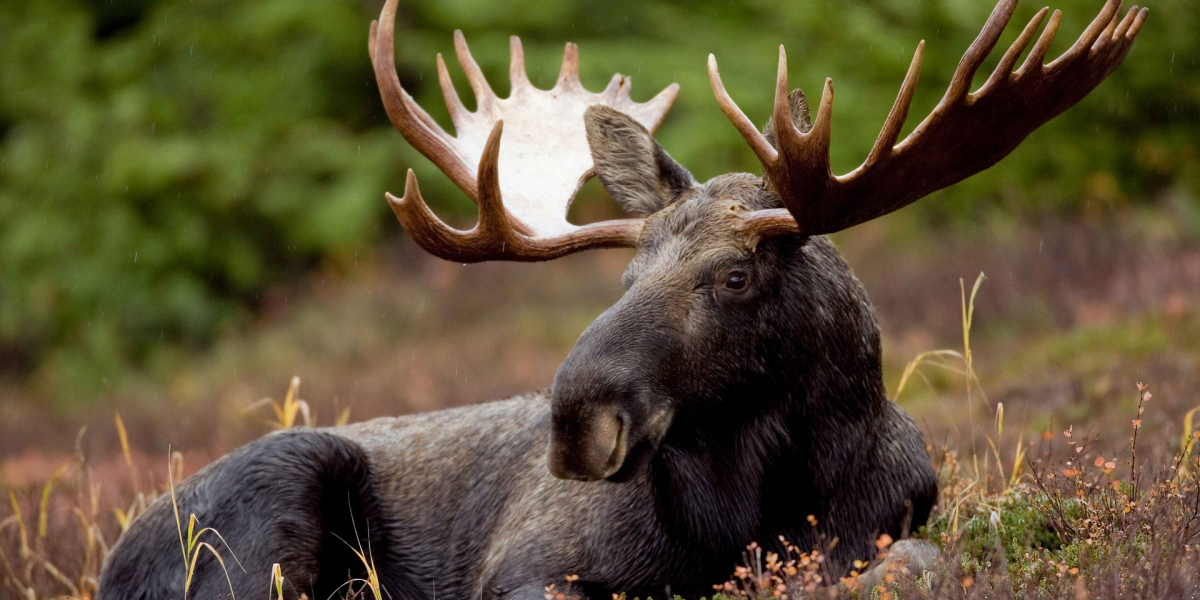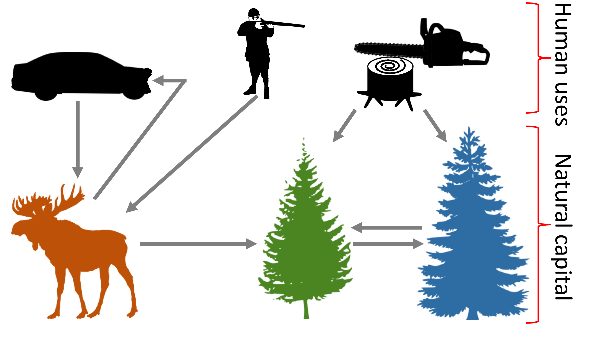
January 13, 2022
Guest post by Robert Buchkowski, Youpei Yan, Alicia Entem, and Shawn Leroux
Interdisciplinary collaboration is sought after as an opportunity to create new solutions to old problems. For example, the management of species at risk has benefited from integrating insights from ecologists, economists, provincial and national government staff, and First Nations communities via an explicit process of considering the knowledge held by each of these groups. As we approach another Convention on Biological Diversity this year, questions around how to get the best outcomes from ecosystem and species management are at the fore.
As a group of ecologists and economists, we come from disciplines with a long history of collaborative effort, especially in the areas of resource management. Bioeconomics is a well-established sub-discipline, while many ecological tools like Ecopath with Ecosim incorporate resource harvesting that yields explicit economic products. Such collaborative efforts leverage the fact that ecologists and economists use compatible analytical tools, built using similar fundamental approaches and mathematical principles.
Despite this history of collaboration, the perception is that ecological studies aimed at protecting ecosystems conflict with economic objectives of maximizing yield. Sustainable yield, a foundation of biological economics, has done little to ameliorate the perceived conflict, perhaps because the ecological models incorporated into these calculations inevitably miss the biodiversity and ecosystem complexity that many conservation biologists hope to preserve.
Even though our tools are theoretically compatible, our disciplinary approaches create divides that become more apparent when we begin to build in the ecological and economic complexity that goes beyond models of ‘maximum sustainable yield’. When one of us (specifically Robert Buchkowski), first started exploring economics, they assumed that units were the largest difference—multiply the amount of timber by price and you are there. In fact, we differ in how we conceptualize the study systems, how we utilize data, and where we hope to apply our models. Our project team has found that merging ecological and economic analyses efficiently requires explicit interdisciplinary collaboration that addresses the implicit questions above.
Back in 2020, our team started a collaboration to analyze the ecological and economic effects of moose populations on the island of Newfoundland. Moose were introduced at the turn of the 20th century to serve as a game species and have since proliferated. Their importance as a source of food, recreation, and tourism value is well-established (e.g. Government of Newfoundland and Labrador). However, moose also suppress the regeneration of native and dominant balsam fir trees and are often involved in collisions with vehicles. So, Newfoundland moose embody this ecological and economic complexity (Figure 1).

Figure 1: Some important ecological and economic factors surrounding moose in Newfoundland. Moose browse balsam fir trees (green) but not their evergreen competitors (spruce; blue). Moose are hunted, involved in vehicle accidents, and indirectly influence forestry.
Natural capital methods provide an opportunity to tease apart such interactions and unite ecological and economic considerations. Despite their conceptual power, such analyses are only as strong as the underlying data and models that inform them. It is here where our group faced the three questions:
We think that addressing these inquiries as an interdisciplinary group will help answer the ultimate question of how to make better management and policy decisions about moose and forests on the island.
We have begun to answer these questions as we build an ecological model of moose and forestry interactions for Newfoundland, with this model leveraging the strengths of both ecological and economic worldviews. The model had to be relatively simple to facilitate our complete analysis, while capturing two important ecological processes: First, moose browse on juvenile fir during the winter and so depress the regeneration of this species; Second, the populations of moose and trees, as well as their interactions, are quite variable across the island.
Building these landscape-level tools is impossible without good data and a clear understanding of them. Members of Newfoundland and Labrador’s Fisheries, Forestry and Agriculture ministry collect and organize these data and so make these detailed analyses possible. While this blog is about collaborations between academic ecologists and economists, the contributions of government scientists collecting, interpreting, and applying these ecological data are essential to this work.
A critical question in how we conceptualized our study system revolved around space—how could we represent variation across Newfoundland without building a complex spatial model? Our ecologists began with a list of grouping variables that could account for spatial relationships at a resolution that kept our model feasible, namely ecoregions, geological features, or watersheds. While these could correct our model predictions by accounting for the fact that adjacent forests tend to be most similar, none of these informed the management of the moose populations, which occurs by moose management area. It turned out, conveniently, that a management area does an equally good job of grouping similar forests as any ecological variable available to us. So, we conceptualized our system by management area because we could confirm that the ecological outcome was analogous (Figure 2).

Figure 2: The distribution of balsam fir across Newfoundland’s moose management areas, as predicted by our ecological model. Units are megagrams per hectare. 1Mg/ha = 1 metric ton/hectare = 0.1 kg/m2.
Just as our ecologists first tried to tie the model to ecologically relevant variables (e.g. watershed), typical bioeconomic models can take ecological interactions for granted or—even worse say our ecologists—treat them as zero! A further concern is how the behavior of local agencies is captured in economic models. We believe that local agencies, who act as social planners to maximize different stakeholders’ welfare, would also observe and utilize any relevant ecological connections (e.g. moose eating fir) for their management of natural resources. And we hope that, intentionally or unintentionally, the management is therefore optimized over the long run.
The benefit of including ecological information in economic models is the link between economic decisions and the information upon which they are based. We assume that decisions about the variables we care about, such as total allowable cuts for a forest and how quotas per moose management area were set every year, are designed to return the highest benefit. For example, hunters vote with their feet to reveal their willingness to pay for a hunting trip and we assume social planners use this information to make decisions about appropriate hunting quotas.
Yet, management decisions are not solely focused on economic outcome, because planners are mandated to balance complicated ecological relationships. Ecological analysis therefore provides two pieces of information: what relationships are known to exist in the ecosystem and what relationships probably exist but are left unaccounted for due to a lack of data or understanding. For instance, we notice that spruce trees negatively impact the moose-fir system through competition. So, the calculated recreational value of moose is affected by spruce. Perhaps more importantly, the rationale for management decisions (e.g. what to plant, what to harvest) balances on whether or not the social planner is ignoring this ecological connection. Future field work and survey data we are in the process of collecting will help confirm which of these cases is closer to reality.
The bio-economic model we are developing will itself, in theory, reveal these concerns and provide a reasonable explanation for the observed natural management among multiple resources that interact with each other. We can also add or drop different constraints for the overall welfare analysis. However, no matter how our economists test and simulate different management scenarios, the fundamental conclusions rely on accurate modeling work from the ecologists on the team.
With our model built, we are facing the thorniest question of all: how can we now apply it? As ecologists, we are exploring how the Newfoundland system is responding to ecological disturbance. As economists, we are exploring how decisions about annual allowable cuts and moose tag quotas can be set to consider the ecological links between moose and trees. We aim to provide these results to help test how a policy change in one area (e.g., moose hunting) might spread throughout forests, onto highways, and into tourism demand. Making these suggestions reasonable is the main benefit of truly interdisciplinary work engaging ecologists, economists, and government scientists. For example, achieving a new moose hunting rate by issuing a new quota will be successful only if we can judge how moose and hunters will respond.
This project, titled “The Newfoundland Moose-forest Ecosystem as a Portfolio of Natural Capital: Accounting for Recreation and Ecosystem Feedbacks”, was funded in part by the Economics and Environmental Policy Research Network (EEPRN) and the Greening Growth Partnership, with funding awarded through Smart Prosperity’s 2020 Call for Proposals. Further details of this and other funded projects are available here.